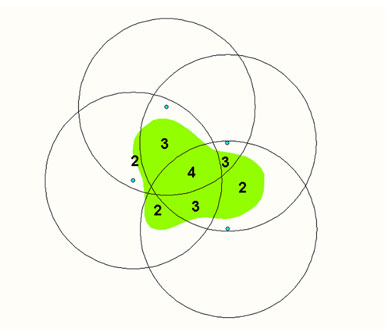Virtual Irrigation Audit
In PACE's presentation at the 2007 Crop Science Society of America (CSSA) meetings, we introduced a concept that we have dubbed "the virtual irrigation audit" which will make it possible, in the near future, to conduct an audit of your irrigation system that does not involve catch cans or even running the irrigation system. While catch-can audits are still necessary for a comprehensive evaluation of irrigation system performance, the virtual irrigation audit can be a fast and fairly accurate diagnostic tool. The same system can also be used to evaluate and improve irrigation system designs even before they are installed. In these days of water shortages and drought-related problems on turf, this is an approach that we believe can save time, money and turf damage.
Our presentation can be found at this link: "Virtual Irrigation Audit"(1,288 KB). A brief summary of the presentation appears below.
Irrigation design problems frequently result in turfgrass stress and damage. Although catch-can evaluations to determine irrigation distribution uniformity are the standard practice, they are cumbersome to conduct and are not practical for diagnostic purposes in real-time. To improve the efficiency of visualizing and diagnosing irrigation design problems, we performed virtual irrigation audits using the following tools:
- a Trimble AgGPS 132 sub-meter GPS receiver
- HGIS software from StarPal
- a TDS Recon hand held computer
(For more information on these tools, see this PACE article on "Precision Management Tools")
Golf course green, tee and fairway perimeters, irrigation sprinkler locations, and the theoretical throw of each irrigation head are easily mapped. The graphics that are generated from this process (see rough map, turf racetrack map and green map) illustrate clearly how water is being distributed from irrigation heads, locates where potential problem areas (too wet or too dry) are likely to occur, and helps diagnose the causes of water-related problems.
In the course of our study, we confirmed what many of you already know — that irrigation designs are woefully deficient in delivering water uniformly to the entire turf surface. In some cases, we found portions of greens that received only 50% of the water that was applied to the wettest areas of the same greens. Deep and infrequent irrigation will help to compensate for these flaws in design, but require heavy water use and may not be sufficient in and of themselves on poa greens where roots are shallow. If short irrigation sets (10 minutes per cycle) are necessary (for example, on poa greens), hand watering will be required to even out soil moisture in areas that receive too little water during the cycle.





